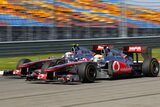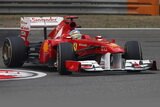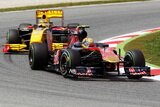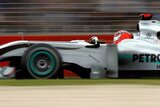The two-mile tracks of Michigan International Speedway and Auto Club Speedway may showcase some of the best racing in NASCAR.
Slightly smaller than Daytona International Speedway and Talladega Superspeedway, that difference means the cars are not fitted with a restrictor plate and all their ponies can run as fast as possible. The track is long enough and the corners wide enough that if a driver has a car capable of running in more than one groove, when he catches his competition he can complete a pass.
Because cars tend to get strung out on this course, it's not uncommon for the race to go long distances without a yellow flag, and Dale Earnhardt Jr.'s ability to squeeze a little more Sonoco fuel out of his Chevy this summer helped him get to Victory Lane for his first win with Hendrick Motorsports. It's ironic that he returns to the site of his first victory -- which came in part by pit strategy -- fresh from a track where a bad pit call cost him a shot at finishing in the top 10. Last week, crew chief Tony Eury Jr. left the No. 88 on course way too long and caused Earnhardt to pit by himself under yellow, but this week could provide absolution.
To be successful at Michigan, teams must have the total package: Horsepower, handling, a hero behind the wheel and he-men in the pits. Oh yeah, and a healthy amount of gasoline just in case the caution waves right on their final fuel window. This is one race where it pays to play conservatively, but the occasional dark horse can also be a great value and a differentiator from your competitor's lineup.
Roush Racing
At Michigan, playing it safe means loading your roster with Roushketeers. Each time the series rolls onto either 2-mile track, this team has to be considered a threat not only with their marquee drivers, but all the way through the lineup. As long as he's been running a multi-car team, Jack Roush has almost always placed at least two of his drivers in the top 10 on a 2-mile track. Last spring at Auto Club was a rare exception when Matt Kenseth won with Greg Biffle finishing 15th as the next highest member of this organization, but the rest of that season was much more typical with two of his drivers in the top 10 and the remainder of them finishing respectably.
In the last three races on this track type, Roushketeers have earned four top-fives, eight top-10s and 12 results of 17th or better in 15 combined starts. During those three races, these five drivers have recorded a combined average finish of 10.6, which means that even when they have missed the top spots, it hasn't been by much. Better still, that success is spread across the organization as all of Roush's drivers earned at least a top-15 in the last three 2-mile attempts.
Carl Edwards has been the standard bearer on this track type since he joined the NASCAR fight. From his debut at Michigan in the 2004 GFS Marketplace 400 through this summer's LifeLock 400 he has failed to crack the top 10 only twice in 16 starts at Michigan and Auto Club and he's finished on the lead lap in all but a single event. One of these poor results came when rain altered the finish of the 2006 fall duel at Michigan and he is the closest thing to a guarantee fantasy owners are going to get this week.
Matt Kenseth has four victories on the 2-mile tracks and enters the weekend with a four-race streak of top-10s. If not for an accident in the 2007 Citizens Bank 400, he would most likely have a 13-race top-15 streak going during which he's averaged a result of 4.7 when he's been running at the end. He can't afford to finish badly this week, as he is still in need of a strong run to solidify his standing in the top 12, and the likelihood of him finishing outside the top 10 is low.
Ironically, Greg Biffle is the only Roushketeer without a top-10 on this track type in the past two years, because at times he's been the cream of their crop. In 2004 and 2005, Biffle won back-to-back Michigan races as well as one of Auto Club's events. He swept the top 10 for the remainder of the 2005 season and nearly won again in the second race at Fontana. Unfortunately, NASCAR is about "what have you done lately," and Biffle's best finish on this track type in his last seven attempts has been a pair of 15ths. Still, he has some recent momentum on his side with three top-15s in his last three oval starts this season, so this could be the weekend he breaks back into the top 10.
In this summer's LifeLock 400, Roush placed four of his five drivers in the top 10 and that included dark-horse appearances by Jamie McMurray and David Ragan. That was McMurray's second top-10 at Michigan in his last three attempts and Ragan's career first but with the momentum the second-year driver currently has, he is the better value this week. In his last four oval-track appearances, Ragan has swept the top 15 and has a pair of fifth-place finishes to his credit. Of course, McMurray has also come on strong with a pair of top-10s in his last two oval starts.
The Other Favorites
The only driver who has been capable of consistently running with Roush on the 2-mile tracks during the last two years has been Jimmie Johnson. Since the start of 2007, he has one victory, a runner-up finish, two third-place finishes and a sixth in six starts, which means he's failed to crack the top 10 only once in that span. Even with a modest 19th-place finish in the summer 2007 Michigan race, he has an average result of 5.7 during that span and he has a ton of momentum on his side. In his last four attempts of 2008, Johnson has won at Indianapolis Motor Speedway, finished second at Chicagoland Speedway, was third at Pocono Raceway and even managed to finish in the top 10 on the road course last week.
Tony Stewart missed two golden opportunities to win in the last two races and settled for back-to-back second-place finishes at Pocono and Watkins Glen International. That may mean he's going to end the season without a single victory since those are two of his strongest tracks, but it doesn't mean he won't be a good fantasy value. At Michigan, Stewart hasn't always run with the lead pack, but he finds a way to finish with them. In his last 12 attempts on this 2-mile oval, he has finished outside the top 10 only twice and he came close to winning on five occasions with second- or third-place finishes in 2002, 2003, 2005, 2006 and as recently as 2007. This summer, he finished fifth on this track.
Dark Horses
Lat year when Red Bull Racing made its stock-car debut, Brian Vickers struggled nearly everywhere, but the only place it seemed he could consistently run strong was on the 2-mile tracks. In four starts at Michigan and Auto Club, he earned three top-10s and he kept that momentum going into 2008 with an 11th in California and a fifth in Michigan so far this season. Both Red Bull racers have been very strong in recent weeks and A.J. Allmendinger is even threatening to crack the top 10 with some regularity, so these two drivers should be watched closely as dark-horse contenders.
Kasey Kahne also deserves a long look this week. During his career, he has swept the top five in even numbered years at Michigan with a second- and fifth-place finish in his rookie season of 2004, a first- and fourth-place finish in 2006 and a second this summer. Moreover, he's earned two top-10s in the last two races at Auto Club, which gives him a three-race streak of such finishes on this track type entering this weekend.
Uncle
Handicapping races is not an easy undertaking. There are so many variables in a race that earning a top-five in NASCAR is one of the toughest tasks in organized sports and Jeff Gordon could be the poster child for this belief. He ran miserably in both road course races this year -- even though he managed to steal a top-five at Infineon Raceway late in the going -- and those were tracks that should have been his to control. Since those courses ran the new car last year, it's hard to blame the new body style for all of his problems, but this team has struggled particularly on the unrestricted, intermediate speedways while trying to walk the razor's edge of setups that the boxy car demands. We're going to cry uncle for the moment, and stop predicting either strong or weak finishes because in the 3M Performance 400 he's as likely to be in the top five as in the high 20s.
Comments:













